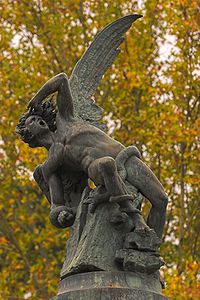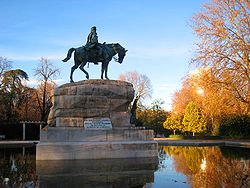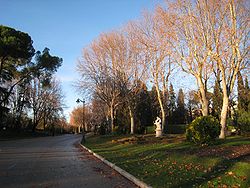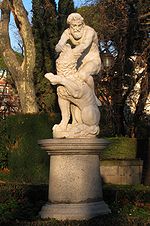
Parque del Buen Retiro
Encyclopedia





Madrid
Madrid is the capital and largest city of Spain. The population of the city is roughly 3.3 million and the entire population of the Madrid metropolitan area is calculated to be 6.271 million. It is the third largest city in the European Union, after London and Berlin, and its metropolitan...
, Spain
Spain
Spain , officially the Kingdom of Spain languages]] under the European Charter for Regional or Minority Languages. In each of these, Spain's official name is as follows:;;;;;;), is a country and member state of the European Union located in southwestern Europe on the Iberian Peninsula...
. The park belonged to the Spanish Monarchy
Spanish monarchy
The Monarchy of Spain, constitutionally referred to as The Crown and commonly referred to as the Spanish monarchy or Hispanic Monarchy, is a constitutional institution and an historic office of Spain...
until the late 19th century, when it became a public park.
Location
The Buen Retiro Park is a large and popular 1.4 km² (345.9 acre) park at the edge of the city center, very close to the Puerta de AlcaláPuerta de Alcalá
The Puerta de Alcalá is a Neo-classical monument in the Plaza de la Independencia in Madrid, Spain. It stands near the city center and several meters away from the main entrance to the Parque del Buen Retiro...
and not far from the Prado Museum. A magnificent park, filled with beautiful sculpture and monuments, galleries, a peaceful lake and host to a variety of events, it is one of Madrid's premier attractions. The park is entirely surrounded by the present-day city.
History of the park and palace
In 1505, at the time of Isabella I (r. 1474–1504) the Jeronimos monastery was moved from an unsuitable location elsewhere to the present site of San Jeronimo el Real Church, and a new monastery built in Isabelline GothicIsabelline Gothic
Isabelline Gothic , is a style of the Crown of Castile during the reign of the Catholic Monarchs, who represents the transition between late Gothic and early Renaissance, with original features and decorative influences of Mudéjar art, Flanders and in a lesser extent, Italy.The Isabelline style...
style. The royal family had a retreat built as part of the church.
King Philip II
Philip II of Spain
Philip II was King of Spain, Portugal, Naples, Sicily, and, while married to Mary I, King of England and Ireland. He was lord of the Seventeen Provinces from 1556 until 1581, holding various titles for the individual territories such as duke or count....
(r. 1556–1598) moved the Spanish court to Madrid in 1561. Philip had the Retiro enlarged by his architect Juan Bautista de Toledo
Juan Bautista de Toledo
Juan Bautista de Toledo. Spanish architect educated in Italy, in the Italian High Renaissance. As many Italian renaissance architects, he had experience in both architecture and military and civil public works. Born, either in Toledo or in Madrid around 1515. Died May 19, 1567 in Madrid...
, and formal avenues
Avenue (landscape)
__notoc__In landscaping, an avenue or allée is traditionally a straight route with a line of trees or large shrubs running along each, which is used, as its French source venir indicates, to emphasize the "coming to," or arrival at a landscape or architectural feature...
of trees were laid out.
The gardens were extended in the 1620s, when Gaspar de Guzmán, Count-Duke of Olivares
Gaspar de Guzmán, Count-Duke of Olivares
Don Gaspar de Guzmán y Pimentel Ribera y Velasco de Tovar, Count-Duke of Olivares and Duke of San Lúcar la Mayor , was a Spanish royal favourite of Philip IV and minister. As prime minister from 1621 to 1643, he over-exerted Spain in foreign affairs and unsuccessfully attempted domestic reform...
, Philip IV
Philip IV of Spain
Philip IV was King of Spain between 1621 and 1665, sovereign of the Spanish Netherlands, and King of Portugal until 1640...
's powerful favourite, gave the king several tracts of land in the vicinity for the Court's recreational use. Olivares determined to build, in a place that the king liked, a royal house which should be superior to those villas that Roman nobles had been setting up in the hilly outskirts of Rome during the previous century. Although this second royal residence was to be built in what were then outlying areas of Madrid, it was actually not far from the existing Alcázar
Alcázar
An alcázar , alcácer or alcàsser is a type of castle in Spain and Portugal. The term derives from the Arabic word القصر meaning "fort, castle or palace"; and the Arabic word is derived from the Latin word, 'castrum', meaning an army camp or fort...
or fortress residence, and the location in a cool, wooded area proved to be ideal.
In the 1630s, under the supervision of architects Giovanni Battista Crescenzi
Giovanni Battista Crescenzi
Giovanni Battista Crescenzi was an Italian painter and architect of the early-Baroque period, active in Rome and Spain, where he helped decorate the pantheon of the Spanish kings at El Escorial....
and Alonso Carbonell, several building were erected in great haste, two of which are still standing: the "Casón del Buen Retiro" which served as a ballroom, and the building that today houses the military museum, the Museo del Ejército, which includes the grand entrance hall, the "Salón de Reinos
Salón de Reinos
The Salón de Reinos or salón grande is a wing of the palacio del Buen Retiro in Madrid. Built between 1630 and 1635, it housed the largest paintings in the royal collection, now all in the Museo Nacional del Prado...
" (Hall of Kingdoms), its wall decorated with paintings by Velázquez
Diego Velázquez
Diego Rodríguez de Silva y Velázquez was a Spanish painter who was the leading artist in the court of King Philip IV. He was an individualistic artist of the contemporary Baroque period, important as a portrait artist...
and Zurbarán and frescoes by Luca Giordano
Luca Giordano
Luca Giordano was an Italian late Baroque painter and printmaker in etching. Fluent and decorative, he worked successfully in Naples and Rome, Florence and Venice, before spending a decade in Spain....
.
The Count-Duke of Olivares commissioned the park in the 1630s, worked on by Cosimo Lotti
Cosimo Lotti
Cosimo Lotti was an Italian engineer, scenographer, and landscape designer. He worked around Florence until in his mid-fifties he moved to Madrid where he produced theatrical spectacles for the royal court....
, a garden designer who had worked under Bernardo Buontalenti
Bernardo Buontalenti
Bernardo Buontalenti, byname of Bernardo Delle Girandole was an Italian stage designer, architect, theatrical designer, military engineer and artist.-Biography:Buontalenti was born in Florence....
on the layout of the Boboli Gardens
Boboli Gardens
The Boboli Gardens are a park in Florence, Italy, that is home to a collection of sculptures dating from the 16th through the 18th centuries, with some Roman antiquities.-History and layout:...
for Cosimo I, Grand Duke of Tuscany. Water was a distinguishing trait of the garden from the outset: the great pond, Estanque del Retiro, which served as the setting for mock naval battles and other aquatic displays, the great canal, the narrow channel, the chamfered or bellflower pond, created —along with the chapels— the basic layout of the gardens. Buen Retiro was described as "The world art wonder of the time", probably the last great creation of the Renaissance in Spain. Buen Retiro became the center of Habsburg
Habsburg
The House of Habsburg , also found as Hapsburg, and also known as House of Austria is one of the most important royal houses of Europe and is best known for being an origin of all of the formally elected Holy Roman Emperors between 1438 and 1740, as well as rulers of the Austrian Empire and...
court life at a time when Spain was the foremost power in the world. During the reigns of Philip IV
Philip IV of Spain
Philip IV was King of Spain between 1621 and 1665, sovereign of the Spanish Netherlands, and King of Portugal until 1640...
and Charles II
Charles II of Spain
Charles II was the last Habsburg King of Spain and the ruler of large parts of Italy, the Spanish territories in the Southern Low Countries, and Spain's overseas Empire, stretching from the Americas to the Spanish East Indies...
several magnificent plays were performed in the park for the royal family and the court.
The gardens were neglected after the death of Philip IV
Philip IV of Spain
Philip IV was King of Spain between 1621 and 1665, sovereign of the Spanish Netherlands, and King of Portugal until 1640...
in 1665, but have been restored and changed on many occasions, notably after being opened to the public in 1767 and becoming the property of the municipality in 1868.
Philip V
Philip V of Spain
Philip V was King of Spain from 15 November 1700 to 15 January 1724, when he abdicated in favor of his son Louis, and from 6 September 1724, when he assumed the throne again upon his son's death, to his death.Before his reign, Philip occupied an exalted place in the royal family of France as a...
(1700–1746) ordered the creation of a parterre
Parterre
A parterre is a formal garden construction on a level surface consisting of planting beds, edged in stone or tightly clipped hedging, and gravel paths arranged to form a pleasing, usually symmetrical pattern. Parterres need not have any flowers at all...
, the only French-style garden in the complex. During the reign of Ferdinand VI
Ferdinand VI of Spain
Ferdinand VI , called the Learnt, was King of Spain from 9 July 1746 until his death. He was the fourth son of the previous monarch Philip V and his first wife Maria Luisa of Savoy...
, Buen Retiro was the setting for magnificent Italian operas. Charles III
Charles III of Spain
Charles III was the King of Spain and the Spanish Indies from 1759 to 1788. He was the eldest son of Philip V of Spain and his second wife, the Princess Elisabeth Farnese...
(1759–1788) saw to the beautification of its perimeter, replacing the old walls with elegant wrought-iron railings. Juan de Villanueva
Juan de Villanueva
Juan de Villanueva was a Spanish architect. Alongside Ventura Rodríguez, Villanueva is the best known architect of Spanish Neoclassicism....
's Astronomical Observatory
Observatory
An observatory is a location used for observing terrestrial or celestial events. Astronomy, climatology/meteorology, geology, oceanography and volcanology are examples of disciplines for which observatories have been constructed...
was built during the reign of Charles IV
Charles IV of Spain
Charles IV was King of Spain from 14 December 1788 until his abdication on 19 March 1808.-Early life:...
(1788–1808).
The Buen Retiro Palace
Buen Retiro Palace
Buen Retiro Palace in Madrid was a large palace complex designed by the architect Alonso Carbonell and built on the orders of Philip IV of Spain as a secondary residence and place of recreation . It was built in what was then the eastern limits of the city of Madrid...
was used until the era of Charles III. Most of the palace was destroyed during the Peninsular War
Peninsular War
The Peninsular War was a war between France and the allied powers of Spain, the United Kingdom, and Portugal for control of the Iberian Peninsula during the Napoleonic Wars. The war began when French and Spanish armies crossed Spain and invaded Portugal in 1807. Then, in 1808, France turned on its...
(1807–1814) with the First French Empire
First French Empire
The First French Empire , also known as the Greater French Empire or Napoleonic Empire, was the empire of Napoleon I of France...
.
The reign of Queen Isabella II
Isabella II of Spain
Isabella II was the only female monarch of Spain in modern times. She came to the throne as an infant, but her succession was disputed by the Carlists, who refused to recognise a female sovereign, leading to the Carlist Wars. After a troubled reign, she was deposed in the Glorious Revolution of...
saw profound changes in the "Retiro". During the queen's minority, the gardens enjoyed a particularly prosperous period, with the planting of shade and fruit trees, and previously unplanted areas like the "Campo Grande", were landscaped as well. The gardens eventually passed to public ownership in 1868, at the time of the overthrow of Queen Isabella.
El Retiro gradually became the green heart of the city. At the beginning of the 20th century, the Monument to Alfonso XII of Spain was erected next to the pond, designed by architect José Grases Riera
José Grases Riera
José Grases Riera was a Catalan architect.Born in Barcelona, Grases graduated from the School of Architecture in Barcelona in 1878 and moved to Madrid shortly after...
. Countless statues, fountains and commemorative monuments have filled the park and converted it into an open-air sculpture museum.
The nineteen-thirties and forties witnessed the creation of new gardens attributed to Chief Gardener Cecilio Rodriguez who designed and built the rose bed and the gardens that have been named to honor him.
Features of the Park
Close to the northern entrance of the park is the Estanque del Retiro ("Retiro Pond"), a large artificial pond. Next to it is the monument to King Alfonso XIIAlfonso XII of Spain
Alfonso XII was king of Spain, reigning from 1874 to 1885, after a coup d'état restored the monarchy and ended the ephemeral First Spanish Republic.-Early life and paternity:Alfonso was the son of Queen Isabella II of Spain, and...
, featuring a semicircular colonnade and an equestrian statue of the monarch on the top of a tall central core.
The Rosaleda rose garden. Among the many rose bushes of all kinds stands the Fountain of the Falling Angel, erected in 1922, whose main sculpture El Angel Caído (at the top) is a work by Ricardo Bellver
Ricardo Bellver
Ricardo Bellver was a Spanish sculptor.- Biography :Bellver studied at the San Fernando Royal Academy of Art, and finished his sculptural education in Rome as a grant holder....
(1845–1924) inspired by a passage from John Milton
John Milton
John Milton was an English poet, polemicist, a scholarly man of letters, and a civil servant for the Commonwealth of England under Oliver Cromwell...
's Paradise Lost
Paradise Lost
Paradise Lost is an epic poem in blank verse by the 17th-century English poet John Milton. It was originally published in 1667 in ten books, with a total of over ten thousand individual lines of verse...
, which represents Lucifer
Lucifer
Traditionally, Lucifer is a name that in English generally refers to the devil or Satan before being cast from Heaven, although this is not the original meaning of the term. In Latin, from which the English word is derived, Lucifer means "light-bearer"...
falling from Heaven. It is claimed that this statue is the only known public monument of the devil.
The few remaining buildings of the Buen Retiro Palace, including Casón del Buen Retiro and the Museo del Ejército, now house museum collections. The Casón has a collection of 19th and 20th century paintings, including art by the Spanish painter Joaquín Sorolla. The Ejército is one of Spain's foremost Army museums and it houses "La Tizona" the sword of the famous Spanish warrior El Cid
El Cid
Rodrigo Díaz de Vivar , known as El Cid Campeador , was a Castilian nobleman, military leader, and diplomat...
. There are displays of armor, a cross carried by Christopher Columbus
Christopher Columbus
Christopher Columbus was an explorer, colonizer, and navigator, born in the Republic of Genoa, in northwestern Italy. Under the auspices of the Catholic Monarchs of Spain, he completed four voyages across the Atlantic Ocean that led to general European awareness of the American continents in the...
on his sea voyage to the New World
New World
The New World is one of the names used for the Western Hemisphere, specifically America and sometimes Oceania . The term originated in the late 15th century, when America had been recently discovered by European explorers, expanding the geographical horizon of the people of the European middle...
and other artifacts.
Since assuming its role as a public park the late 19th century, the "Parque del Retiro" has been used as a venue for various international exhibitions. Several emblematic buildings have remained as testimony to such events, including the Minig building, popularly known as the Velázquez Palace (1884) by architect Ricardo Velázquez Bosco, and the Palacio de Cristal
Palacio de Cristal
Palacio de Cristal, "Crystal Palace" is a glass palace located in Madrid's Buen Retiro Park. It was built in 1887 to exhibit flora and fauna from the Philippines. It is high and is currently used for art exhibits.. It was built within 4 months which is relatively quick for its era.-References:...
("Crystal Palace"), a glass pavilion inspired by The Crystal Palace
The Crystal Palace
The Crystal Palace was a cast-iron and glass building originally erected in Hyde Park, London, England, to house the Great Exhibition of 1851. More than 14,000 exhibitors from around the world gathered in the Palace's of exhibition space to display examples of the latest technology developed in...
in London
London
London is the capital city of :England and the :United Kingdom, the largest metropolitan area in the United Kingdom, and the largest urban zone in the European Union by most measures. Located on the River Thames, London has been a major settlement for two millennia, its history going back to its...
, undoubtedly the gardens' most extraordinary building. Built along with its artificial pond in 1887 by architect Ricardo Velázquez Bosco for the Philippine Islands Exhibitions, it was first used to display flower species indigenous to the islands. The landscape-style gardens located in the former "Campo Grande" are also a reminder of the international exhibitions that have taken place here in the past.
The Paseo de la Argentina, also popularly known as Paseo de las Estatuas ("Statue Walk"), is decorated with some of the statues of kings from the Royal Palace, sculpted between 1750 and 1753.
There are now art galleries in the Crystal Palace, Palacio de Velázquez, and Casa de Vacas.
In the Retiro Park is also the Forest of the Departed
Forest of the Departed
The Forest of Remembrance , formerly known as the Forest of the Departed , is a memorial garden located in the park of El Retiro in Madrid, Spain that commemorates the 191 civilian victims of the 2004 Madrid train bombings and the special forces agent who died in the attacks on 11 March 2004...
(Bosque de los Ausentes), a memorial monument to commemorate the 191 victims of the 11 March 2004 Madrid attacks.
Activities
From late May through early October, every Sunday at midday, the Banda Sinfónica de Madrid gives free concerts from the bandstandBandstand
A bandstand is a circular or semicircular structure set in a park, garden, pier, or indoor space, designed to accommodate musical bands performing concerts...
in the park near the Calle de Alcalá. Manuel Lillo Torregrosa
Manuel Lillo Torregrosa
Manuel Lillo Torregrosa is a Spanish composer born in 1940 in San Vicente del Raspeig, Alicante. He joined the Banda Sinfónica Municipal de Madrid in 1959, and became E-flat clarinet soloist for them...
composed 'Kiosko del Retiro' to this bandstand.
The Park also features an annual Book Fair.
Around the lake, Retiro Pond, many puppet shows perform, and all manner of street performers and fortune tellers. Rowboats can be rented to paddle about the Estanque, and horse-drawn carriages are available.

